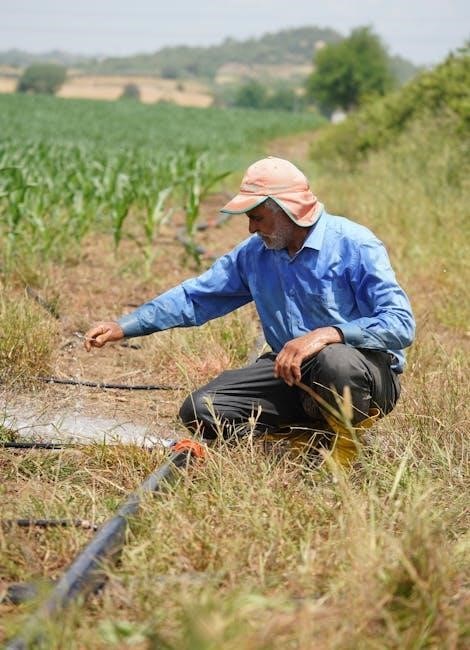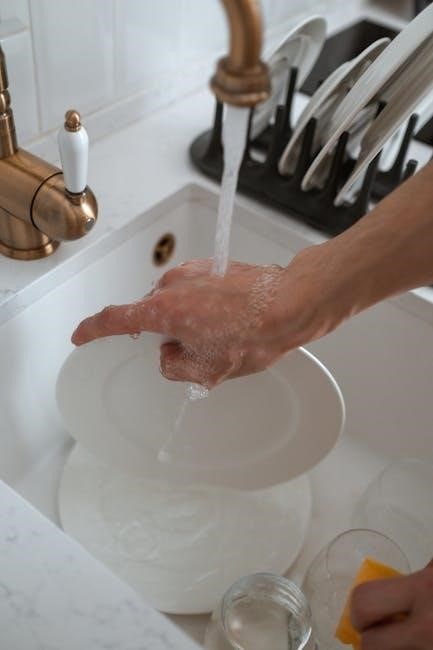Manual water pumps are efficient, durable devices designed to extract water from various sources. They require correct materials, proper installation, and regular maintenance to ensure reliable operation and longevity.
Definition and Purpose of Manual Water Pumps
A manual water pump is a device operated by hand to extract water from a source, such as wells, tanks, or flooded areas. It is a simple, cost-effective solution for water extraction in domestic, agricultural, and marine settings. These pumps are designed to function without electricity, making them ideal for remote locations or emergency situations. Their primary purpose is to provide a reliable means of accessing water when other methods are unavailable. Manual water pumps are often used for irrigation, drinking water supply, and draining water from boats or flooded spaces. They are durable, easy to maintain, and suitable for various water quality conditions. By leveraging mechanical energy, these pumps ensure consistent water flow, making them indispensable in both everyday and challenging environments. Their versatility and simplicity have made them a crucial tool for water management across different industries and applications.
Importance of Manual Water Pumps in Various Applications
Manual water pumps play a vital role in diverse applications, ensuring reliable water supply and drainage in domestic, agricultural, and marine environments. In domestic settings, they provide clean water for households, especially in rural areas with limited access to electricity. Agriculturally, these pumps irrigate crops, supporting food production and sustaining livelihoods. In marine contexts, they are essential for draining water from boats, preventing flooding and ensuring safety; During emergencies like floods, manual pumps are crucial for removing water quickly and efficiently. Their simplicity and durability make them ideal for remote locations where power availability is inconsistent. Additionally, they serve as a sustainable solution for water extraction, reducing reliance on electric pumps and lowering operational costs. Overall, manual water pumps are indispensable tools for managing water resources effectively across various industries and scenarios, ensuring accessibility and reliability wherever they are deployed.

Installation Requirements for Manual Water Pumps
Manual water pumps require proper installation, including correct location, adequate suction pipe length, and non-return valves. Ensure the pump is filled with water and placed on a stable, level surface for optimal performance.
Location and Placement of the Pump
The location and placement of a manual water pump are critical for efficient operation. It should be positioned close to the water source to minimize suction lift and ensure optimal flow rate. The pump must be installed on a stable, level surface to prevent vibration and improper functioning. For marine applications, the pump should be easily accessible, preferably near the bilge area, to facilitate quick water removal. In domestic or agricultural settings, it should be placed in an area protected from extreme weather conditions to prolong its lifespan. Additionally, the pump should be located away from potential contaminants to maintain water quality. Proper placement also ensures compliance with safety regulations, such as being within reach for manual operation and away from hazardous materials. Correct installation in terms of elevation and proximity to the water source is essential for its performance and durability.
Suction and Discharge Pipe Requirements
Proper suction and discharge piping is essential for the efficient operation of manual water pumps. The suction pipe should be as short as possible and free from kinks or obstructions to avoid restricting water flow. It must also be of adequate diameter to handle the required volume, typically between 1 to 2 inches, depending on the pump’s capacity. The discharge pipe should be durable, resistant to corrosion, and appropriately sized to minimize pressure drop. Both pipes should be securely connected to the pump to prevent leaks and ensure a tight seal. In marine applications, the discharge pipe must be long enough to expel water over the side of the boat, while in domestic use, it should direct water to the desired location safely. Regular inspection of these pipes is crucial to identify and address any blockages or damage promptly. Proper installation and maintenance of suction and discharge pipes are vital for optimal pump performance and longevity.

Operational Requirements of Manual Water Pumps
Manual water pumps require regular operation checks, proper priming, and alignment of moving parts. They must be used within specified pressure and flow limits to ensure efficiency and prevent wear.
Capacity and Flow Rate Specifications
The capacity and flow rate of a manual water pump are critical for ensuring its effectiveness in various applications. The pump must be capable of handling the required volume of water efficiently, typically measured in liters per minute (l/min). For smaller applications, such as domestic use, a flow rate of 4.5 l/min may suffice, while larger systems, like those used in marine or agricultural settings, may require higher capacities to meet demand. The pump’s performance is often influenced by factors such as the diameter of the suction and discharge pipes, the length of the pipes, and the vertical lift required. Proper sizing ensures optimal efficiency and prevents overwork, which can lead to wear and tear. Additionally, the pump’s material and design must align with the intended use, such as handling clean water, glycol mixtures, or other fluids. Regular maintenance, including checking for air leaks and ensuring proper priming, is essential to maintain the specified flow rate and overall performance.
Material Compatibility with Water and Other Liquids
Material compatibility is a crucial factor in the selection and operation of manual water pumps. The pump’s components must be resistant to corrosion and degradation when exposed to water and other liquids. Common materials include stainless steel, fluoroplastics, and ultra-high molecular weight polyethylene (UHMWPE), which are known for their durability and resistance to various chemical substances. For instance, fluoroplast-4 is often recommended for its excellent chemical resistance, making it suitable for pumping glycol mixtures and other corrosive liquids. Additionally, the materials must withstand the temperature and pH levels of the liquids being pumped, as specified by the pump’s design. The pH of water, for example, should ideally range between 6.5 and 8.5 to prevent damage. Ensuring material compatibility ensures the pump operates efficiently, prolongs its lifespan, and prevents contamination of the pumped liquids. Regular inspection of the pump’s materials is essential to maintain reliability and safety in all applications.

Maintenance and Care for Manual Water Pumps
Regular inspection and cleaning are essential to ensure optimal performance and longevity of manual water pumps. Proper lubrication and timely replacement of wearable parts prevent mechanical failure and maintain efficiency.
Regular Inspection and Cleaning
Regular inspection and cleaning are essential for maintaining the efficiency and longevity of manual water pumps. Users should check for wear and tear on movable parts, such as pistons and valves, and replace them if necessary. The pump and suction line must be free from debris, sediment, and corrosion, which can obstruct water flow. Cleaning should involve flushing the pump with clean water and removing any blockages in the inlet or outlet pipes. Lubrication of moving parts, as specified by the manufacturer, is also crucial to ensure smooth operation. Additionally, inspect the suction hose for cracks or damage and replace it if compromised. Regular maintenance prevents contamination, reduces the risk of mechanical failure, and ensures consistent performance. It is recommended to perform these checks monthly or more frequently in high-use applications. Proper care extends the lifespan of the pump and guarantees reliable service;
Lubrication and Replacement of Wearable Parts
Proper lubrication is critical for the smooth operation of manual water pumps. Moving parts, such as pistons and valves, should be lubricated regularly with silicone-based grease or other non-corrosive lubricants to reduce friction and wear. Wearable parts, including seals, O-rings, and gaskets, must be inspected periodically for signs of deterioration, such as cracks or leakage. These components should be replaced immediately if damage is detected to prevent water seepage and maintain efficiency. The frequency of lubrication and part replacement depends on usage, with recommendations typically outlined in the manufacturer’s guidelines. Failure to lubricate or replace worn parts can lead to reduced performance, increased effort required to operate the pump, or even complete failure. Regular maintenance ensures the pump remains functional, durable, and reliable over time. Always use compatible materials for replacements to avoid chemical reactions with the water or other liquids being pumped.
Regulatory and Safety Requirements
Manual water pumps must meet local and international standards, ensuring safe operation and environmental compliance. They should be constructed from durable, corrosion-resistant materials to withstand various water conditions and prevent contamination. Regular inspections and adherence to safety protocols are essential to maintain functionality and prevent accidents. Compliance with regulations ensures reliability, efficiency, and safety in all applications. Proper installation, usage, and maintenance are crucial to uphold these standards and prolong the pump’s lifespan. Always follow manufacturer guidelines and regulatory requirements for optimal performance and safety.
Compliance with Local and International Standards
Manual water pumps must adhere to local and international standards to ensure safety, efficiency, and environmental sustainability. These standards often dictate material quality, performance metrics, and operational guidelines. For instance, pumps must be constructed from durable, corrosion-resistant materials like fluoroplast-4 or UHMWPE to withstand various water conditions. Additionally, they should meet specified flow rates and pressure requirements to guarantee reliable performance. Compliance also involves design features that prevent contamination and ensure longevity. Many standards require pumps to undergo rigorous testing to verify their efficiency and durability. Furthermore, adherence to international norms ensures that manual water pumps can be used across different regions without compromising safety or effectiveness. Proper certification and labeling are often mandatory to confirm compliance. By meeting these standards, manual water pumps contribute to sustainable water management and environmental protection. Regular inspections and maintenance are also critical to uphold compliance and ensure continued safe operation.
Safety Precautions for Operation and Handling
Operating a manual water pump safely requires adherence to specific guidelines to prevent accidents and ensure effective functionality. Users should always read and understand the pump’s manual before use, as improper handling can lead to mechanical failure or injury. It is crucial to ensure the pump is properly grounded and that all connections are secure to avoid electrical hazards. When not in use for extended periods, such as over 30 days, the pump should be shut down and drained to prevent damage from stagnant water. Additionally, the float switch should be operated manually to remove residual water. Regular inspections of wearable parts, like valves and seals, are essential to maintain performance and safety. Proper lubrication of moving components can prevent overheating and wear. Always ensure the pump is used within its specified capacity and pressure limits to avoid overloading. Following these precautions ensures safe, efficient, and reliable operation of the manual water pump.
Technical Specifications for Manual Water Pumps
Manual water pumps must meet specific performance and compatibility standards. They should handle various water qualities, operate within optimal temperature ranges, and maintain efficient flow rates and pressure outputs to ensure reliable service.
Performance Metrics: Flow Rate, Pressure, and Efficiency
Manual water pumps are evaluated based on their flow rate, pressure, and efficiency, which determine their suitability for various applications. Flow rate measures the volume of water pumped per unit time, typically expressed in liters per minute (l/min) or gallons per minute (gpm). Pressure, often measured in meters of head or pounds per square inch (PSI), indicates the pump’s ability to lift water to a desired height or overcome system resistance. Efficiency reflects how effectively the pump converts input energy into water movement, usually expressed as a percentage; For example, a pump with a flow rate of 4.5 l/min and a pressure of 10 meters of head might achieve an efficiency of 70-80%. Higher efficiency reduces energy consumption and prolongs pump lifespan. Material quality, design, and maintenance significantly impact these metrics. Ensuring the pump operates within its specified performance range is crucial for optimal functionality and durability.
Compatibility with Water Quality and Temperature
Manual water pumps must be compatible with varying water qualities and temperatures to ensure reliable operation. The pump’s materials should withstand corrosion from acidic, alkaline, or neutral water, with a recommended pH range of 6.5 to 8.5. For handling seawater or brackish water, pumps made from durable, marine-grade materials like stainless steel or fluoroplast-4 are essential. Temperature compatibility is equally critical, as extreme heat or cold can affect pump performance and longevity. Most manual pumps operate effectively within a temperature range of 0°C to 60°C, though specialized models may handle higher temperatures. Compatibility with water quality also involves resistance to sediment, abrasives, or chemicals, depending on the application. Ensuring the pump is designed for the specific water conditions ensures optimal performance, prevents premature wear, and extends its service life. Proper material selection and design features are vital to meet these requirements effectively.

Environmental and Usage Considerations
Manual water pumps are suitable for domestic, agricultural, and marine use, offering sustainable solutions for water extraction. They minimize environmental impact with low energy consumption and eco-friendly designs.
Appropriate Applications: Domestic, Agricultural, and Marine Use
Manual water pumps are versatile tools suitable for various applications. In domestic settings, they provide reliable water supply in areas with limited electricity, ideal for drinking, cooking, and cleaning. For agricultural use, these pumps irrigate crops and water livestock, especially in remote areas. Marine applications require manual bilge pumps to remove water from boats, ensuring safety and compliance with regulations. Domestic pumps often serve small households, while agricultural models handle larger water demands. Marine pumps must meet specific standards for capacity and material durability. Additionally, manual pumps are used in flood relief and emergency situations to pump water efficiently. Their portability and simplicity make them essential across these sectors.
Environmental Impact and Sustainable Use
Manual water pumps are eco-friendly solutions that minimize environmental harm. They operate without electricity, reducing carbon emissions and energy consumption. Their durability and resistance to wear ensure long-term use, minimizing waste. Made from recyclable materials like metal or high-quality plastics, these pumps support sustainable practices. Ideal for remote areas with limited power access, they promote water conservation by encouraging responsible usage. Regular maintenance, such as lubrication and part replacement, extends their lifespan, reducing the need for frequent replacements. Their water-efficient design ensures minimal waste, making them suitable for small-scale applications. Additionally, manual pumps are cost-effective alternatives to electric models, reducing reliance on non-renewable energy sources. By adopting manual water pumps, users contribute to a greener environment while meeting their water needs sustainably. Their simplicity and reliability make them a preferred choice for eco-conscious individuals and communities.
Manual water pumps are essential tools for efficient water extraction, offering durability and reliability. Proper installation, maintenance, and adherence to safety standards ensure optimal performance and environmental sustainability.
Manual water pumps must meet specific criteria to ensure reliable performance. The pump material should be compatible with water and other liquids, while its design must accommodate the required flow rate and pressure. Proper installation is critical, including correct placement to avoid air entry into the suction pipe. Regular maintenance, such as cleaning and lubricating moving parts, is essential to prevent wear and tear. The pump should be capable of operating within a pH range of 6;5 to 8.5 for water and handle varying viscosities for other liquids. Storage and operation must comply with safety standards, and the pump should be Idle for extended periods. Finally, selecting the right pump for the application, whether domestic, agricultural, or marine, ensures efficiency and sustainability. Adhering to these requirements guarantees optimal functionality and longevity of the manual water pump.
Final Recommendations for Choosing the Right Manual Water Pump
When selecting a manual water pump, prioritize your specific needs and application. Assess the required flow rate, pressure, and compatibility with the liquid being pumped. Opt for durable materials like fluoroplast-4 or UHMWPE for longevity. Ensure the pump meets local and international standards, such as the Minimum Efficiency Index (MEI), for optimal performance. Consider the pump’s suitability for domestic, agricultural, or marine use, as each application may demand unique features. For marine use, ensure the pump meets size and capacity regulations, especially for boats over 9 meters. Regular maintenance, including lubrication and part replacement, is crucial for sustained functionality. Always follow safety guidelines and operating instructions to avoid damage or inefficiency. By aligning your choice with these factors, you can ensure reliable, efficient, and safe operation of your manual water pump. Consulting professionals for specific requirements is highly recommended to make an informed decision.
